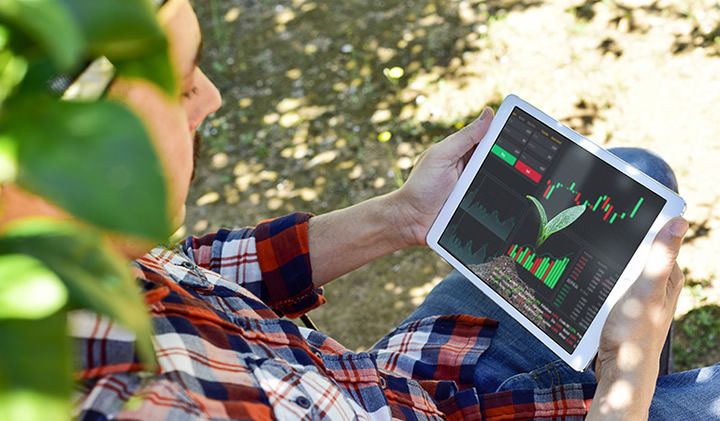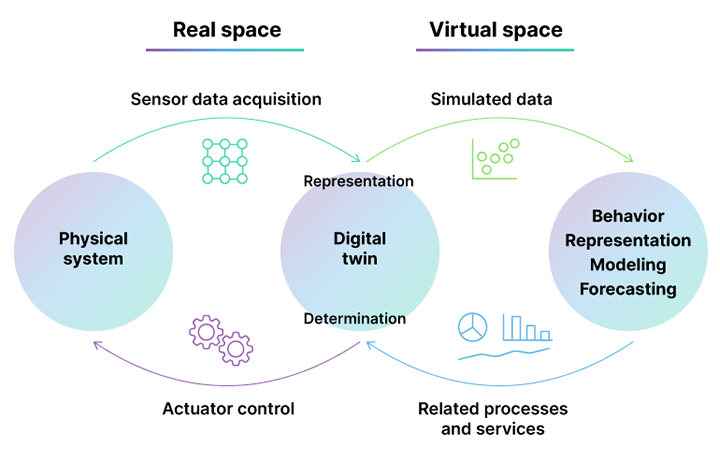Let’s explore what digital twins are, their top benefits, diverse use cases, and how digital twinning is enabling efficient, safe, and sustainable smart farming.
 Digital Twins in Agriculture: A Time Machine for Your Farm
Digital Twins in Agriculture: A Time Machine for Your Farm

Alina Piddubna, Delivery Director, AgriTech Practice Leader | Intellias
If you could build a time machine, would you rather travel back in time to make changes in the past or take a sneak peek into the future to foresee possible outcomes? Digital twins in agriculture let you do both. They’re virtual time machines, providing insights on critical assets and operations at specific points in your farm’s past, present, and future.
Introducing digital twins to agriculture is rapidly moving from concept to reality, with digital twin technology making its way to fields and barns. In doing so, it is transforming the day-to-day operations of agribusinesses, affecting how they manage their processes, systems, and facilities. On a global scale, this new technology is becoming the driving force for a sustainable future, removing uncertainties in crop cultivation, livestock farming, and climate change impacts.
Let’s explore what digital twins are, their top benefits, diverse use cases, and how digital twinning is enabling efficient, safe, and sustainable smart farming.
What are digital twins and how do they work?
Digital twins debuted in 2010 when NASA built a complete virtual replica of their spacecraft that changed in sync with its physical twin. Today, digital twinning is among the hottest emerging technologies and is reshaping entire industries, bringing together the physical and virtual worlds to uncover insights and actions that drive immense business value.
Demand for digital twin solutions in manufacturing is rising sharply, and the global digital twins market is expected to exceed $73.5 billion by 2027.
A digital twin is an accurate virtual representation of a physical object in a digital environment that is used to remotely monitor the physical object’s performance around the clock, collect and analyze data, simulate real-world scenarios and their outcomes, make data-powered decisions, and provide corrective recommendations if necessary.
Powered by the latest innovations in IoT technology, cloud computing, and artificial intelligence, digital twins capture massive amounts of data from environmental sensors and convert that data into insights with the help of a cloud-based processing model. Through a digital twin interface, users can view information on an object’s present condition, history, or predicted future.
Digital twin technology is a two-way street: data flows back and forth between a physical object and its digital double. If there’s a change in the actual asset, this change is mirrored in the digital twin. Conversely, changes made to the digital twin can be implemented in the real world.
Data interaction between the physical object and its digital representation in a digital twin

Source: MDPI
The role of digital twins in agriculture
In agriculture, digital twin technology allows farmers to create a digital model of an entire agricultural ecosystem, including fields, facilities, crops, animals, and machinery. Digital counterparts of farm assets can be used to track the health of soil, crops, or livestock, analyze farm operations, act on real-time insights, and predict future outcomes.
With environmental concerns and the challenge of growing enough food to feed an increasing number of people, farmers are under pressure to enhance yield efficiency and food quality, minimize the cost of maintenance and logistics, ensure farm sustainability, and mitigate unpredictable risks like extreme weather or crop diseases. Applying digital twins in agriculture sector holds tremendous promise to address these challenges.
For a digital twin to serve as a precise counterpart for a real-world object, it requires sufficient data. Digital twins rely on pervasive real-time data collection from various sources, including satellites, drones, embedded sensors, and RFID tags, as well as historical information on soil management, planned crops, and weather patterns.
By analyzing consolidated data from a single digital twin platform, farmers can foresee potential deviations, simulate effects of interventions, and effectively respond to possible issues (or prevent them altogether). All these measures can be taken remotely, without the need for immediate on-site examination.
With digital twins, you get a continuous monitoring and reporting system that alerts you of pest-affected plants, a cow’s poor health, an equipment malfunction, soil dryness, or a temperature drop. Digital twins are also a powerful simulation and prediction tool to envision the impact of farming practices and the forces of nature on your business and prepare for possible scenarios.
Digital twins in farming: From field to screen to harvest
Adopting digital twin technology can empower farmers with unparalleled insights and foresight into their fields, provided it’s implemented effectively. Here’s a stepwise approach to embracing the transformative impact of digital twins in farming:
Real-time data collection
Data gathered from in-field sensors, remote sensing systems, soil probes, weather forecasts, and other sources can provide live insights into critical variables such as humidity, pH level, temperature, nutrients, pest infestation, soil depletion, and weather impacts.
For data to be precise and reliable, sensors and data sources should be regularly calibrated. This will ensure the accuracy of a digital twin’s forecasts and suggestions.
Building a digital duplicate
Using digital twin software, farm operators can create a virtual replica of a field that reflects its characteristics, including field size and shape, topography, soil types, microclimate, sunlight exposure, planting patterns, drainage, and cultivation history. The software must be compatible with the data sources to seamlessly integrate data and provide accurate results.
Data integration
Amassed data is filtered to ensure only relevant data is integrated into the digital twin model, where algorithms analyze and interpret it. This data integration strategy allows for a holistic view of a field’s status to evaluate the interplay of diverse factors and their impact on crop vitality and yields.
Observation and analysis
Digital twins create a real-time reflection of a field’s current state, helping farmers closely monitor crops, soil, and weather to understand plant growth patterns, evaluate resource needs, and react to crop diseases. Early detection of possible disruptions enables timely corrective measures, reduces risks, and enhances crop health and farm productivity.
Prediction and simulation
Predictive capabilities of digital twin technology powered by artificial intelligence and machine learning help farmers mitigate the risk of crop failure by detecting issues in advance, conducting preventive equipment maintenance, and providing instant solutions. Digital twins are also helpful in forecasting weather patterns and understanding the long-term consequences of climate change.
A crop model can simulate how a plant would grow in different conditions and scenarios based on soil, nutrient, and weather data. Soil simulations replicate properties of specific soil types, assisting in optimizing nutrient and water management. Simulations allow farmers to predict growth patterns, experiment, and fine-tune their farming strategies without environmental or financial risks.
Optimization and decision-making
Real-time insights from a virtual farm can guide data-driven decisions. Based on these insights, farmers can adjust crop rotation, planting dates, irrigation, fertilization, and pest control, manage their resources more efficiently, and optimize logistics and supply chains. This leads to improved yields, cost savings, and optimized resource use, ensuring environmentally sustainable operations.
Unlocking the value of digital twins for agriculture: Benefits and use cases
Digital twin technology is revolutionizing the agricultural industry and redefining traditional farming practices on many levels and in many areas. The following are key applications of digital twins in agriculture, highlighting the benefits of integrating twinning into your farm ecosystem.
Continue reading the full article here:
 Alina Piddubna is a passionate AgriTech leader, driven by the mission to guide agricultural players in embracing digital transformation through advanced data and AI/ML technology solutions. Alina’s strong background in managing diverse project portfolios, providing insightful technology consulting, and building impactful digital strategies empowers organizations on their transformation journeys.
Alina Piddubna is a passionate AgriTech leader, driven by the mission to guide agricultural players in embracing digital transformation through advanced data and AI/ML technology solutions. Alina’s strong background in managing diverse project portfolios, providing insightful technology consulting, and building impactful digital strategies empowers organizations on their transformation journeys.
An industry practitioner for over 15 years, Alina uses her rich domain expertise and profound understanding of agricultural market trends to build successful strategic partnerships and deliver exceptional results for global clients.
The content & opinions in this article are the author’s and do not necessarily represent the views of AgriTechTomorrow
Comments (0)
This post does not have any comments. Be the first to leave a comment below.
Featured Product

